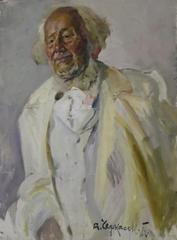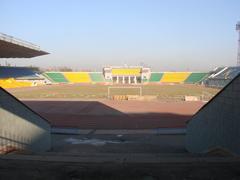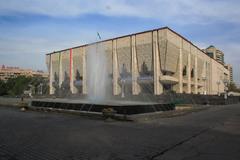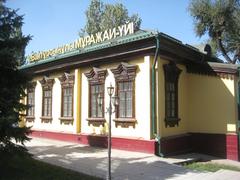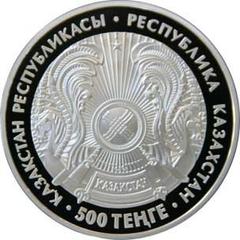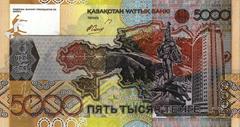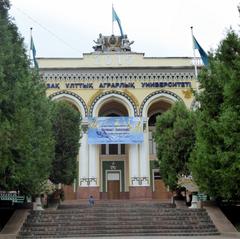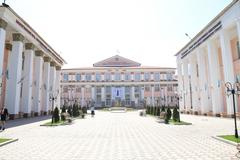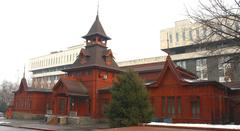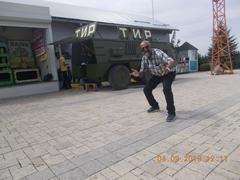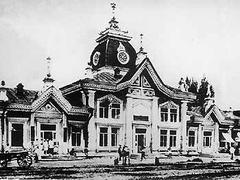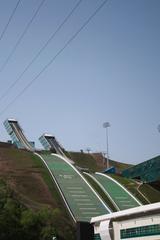
Ascension Cathedral Almaty: Visiting Hours, Tickets, and Comprehensive Travel Guide
Date: 03/07/2025
Introduction
Located in the verdant expanse of Panfilov Park in central Almaty, Kazakhstan, the Ascension Cathedral—also known as Zenkov Cathedral—is an outstanding architectural and cultural landmark. Renowned as one of the tallest wooden buildings in the world, this cathedral is constructed entirely from timber without the use of nails, showcasing remarkable engineering by architect Andrei Pavlovich Zenkov. Since its completion in 1907, the cathedral has withstood earthquakes, political upheavals, and periods of secularization, all while maintaining its spiritual and cultural significance (Wikipedia; aboutkazakhstan.com; kazakhstan-tourism.com).
This guide combines historical context, architectural highlights, practical visiting information, and travel tips to ensure an enriching and well-prepared visit to one of Kazakhstan’s most treasured sites (audiala.com).
Historical and Cultural Background
Origins and Construction
The cathedral’s story began in late 19th-century Verny (now Almaty), as the city developed into a key regional hub with a growing Russian Orthodox community (pck.kz). Plans for a grand Orthodox cathedral materialized at the dawn of the 20th century, culminating in the consecration of its foundation in 1903. Zenkov’s innovative approach involved interlocking timber joints and a flexible framework, allowing the cathedral to withstand the devastating 1911 earthquake with minimal damage (aboutkazakhstan.com; travelsetu.com).
Architectural Significance
Ascending to a height of 56 meters, the cathedral is a marvel of earthquake-resistant wooden architecture. Its pastel-hued domes and ornate carvings exemplify Russian Orthodox and Byzantine styles, while the interior features luminous frescoes and a masterfully painted iconostasis by N. Khludov. Many interior elements were crafted in Moscow and Kiev, underlining the cathedral’s pan-Orthodox significance (touristplaces.guide; wikipedia).
Survival and Transformation
During the Soviet era, the cathedral was repurposed as a museum and housed Almaty’s first radio transmitters. Despite secularization, preservation efforts safeguarded its structure. Independence in the 1990s saw its return to religious use, with restoration projects completed in 1995 and subsequent years, reinstating its spiritual and communal role (welcome.kz; explorekazakhstan.com).
Architectural and Artistic Highlights
- Earthquake-Resistant Timber Construction: Built entirely from wood using interlocking joints and little or no nails, the cathedral’s design enhances flexibility and durability (nomads-life.com).
- Russian Orthodox and Byzantine Styles: Five domes, vibrant exteriors, and intricate woodwork blend Russian Orthodox tradition with local influences (kazakhstan-tourism.com).
- Interior Iconography: Lavish frescoes, a gilded iconostasis, and stained glass windows contribute to a serene, spiritual ambiance (discoverqazaqstan.com).
- Bell Tower: The 54–56-meter-high bell tower provides panoramic views of Almaty when accessible to visitors.
Cultural and Spiritual Significance
The cathedral is an active center for Orthodox worship, hosting liturgies, sacraments, and major religious celebrations. It also serves as a communal gathering place and a symbol of resilience and national identity. Restoration campaigns in 2004 and 2017, involving international experts, have ensured the preservation of its unique wooden structure and artistic heritage (welcome.kz).
Beyond its religious function, the cathedral stands as a living museum and educational resource, hosting guided tours and cultural events to foster cross-cultural understanding and celebrate Kazakhstan’s rich diversity (audiala.com).
Visitor Information
Location
- Address: Panfilov Park, central Almaty
- Nearby Attractions: Kazakh Museum of Folk Musical Instruments, Central State Museum, Green Bazaar
Visiting Hours
- Open daily from 9:00 AM to 6:00 PM (services and hours may vary on major Orthodox holidays)
- Best visited in the late afternoon for optimal lighting and ambiance
Tickets and Entry
- Entry is free; donations are welcome to support restoration and community programs
Guided Tours
- Guided tours are available in multiple languages and can be booked through local operators or on-site
- Tours provide historical and architectural insights and are recommended for a deeper experience
Accessibility
- The cathedral and park are wheelchair accessible, with ramps at entrances
- Some interior areas may have steps; staff are available to assist as needed
Photography
- Photography is permitted (no flash or tripods during services)
- The colorful domes and the park’s natural beauty offer excellent photo opportunities
Cultural Etiquette
- Modest dress is advised; women may cover their heads, men should remove hats
- Maintain respectful silence, especially during services
Special Experiences and Events
- Morning Liturgy: Daily 8 AM liturgies offer a chance to hear traditional Slavonic hymns in a tranquil setting
- Religious Festivals: Major Orthodox holidays, such as Easter and Christmas, feature special services and processions
- Commemorative Coin: The cathedral was featured on a 2007 silver coin issued by the National Bank of Kazakhstan (wikipedia)
Nearby Attractions
- Kazakh Museum of Folk Musical Instruments: Explore Kazakhstan’s musical heritage
- Central State Museum: Learn about the country’s history and culture
- Green Bazaar: Sample local cuisine and purchase souvenirs in a lively market setting
Practical Tips
- Language: Basic Russian or Kazakh is helpful; translation apps are advisable
- Transport: Walk, taxi, or public transport from most city locations
- Best Season: Spring and autumn for mild weather; winter for picturesque snow scenes
- Safety: Panfilov Park is safe, but always mind your belongings
Emotional and Spiritual Impact
A 2023 study found that visits to the cathedral evoke a sense of peace, happiness, and spiritual fulfillment—even among non-Orthodox tourists (ijtcs.usc.ac.ir). The cathedral’s welcoming environment and universal themes of resilience and faith resonate widely.
Frequently Asked Questions (FAQ)
Q: What are the Ascension Cathedral visiting hours?
A: Daily from 9:00 AM to 6:00 PM; check for special holiday schedules.
Q: Is there an entrance fee?
A: Entry is free; donations are appreciated.
Q: Are guided tours offered?
A: Yes, in several languages—book on-site or with local agencies.
Q: Is the cathedral accessible for visitors with disabilities?
A: Yes, with ramps and assistance available.
Q: Can I take photos inside?
A: Yes, without flash and not during services.
Q: What else is nearby?
A: The cathedral is within walking distance of museums, the Green Bazaar, and other cultural sites.
Conclusion and Recommendations
The Ascension Cathedral is a symbol of faith, resilience, and cultural continuity. Its unique wooden construction, vibrant design, and storied history make it a must-visit for anyone interested in Kazakhstan’s architectural and spiritual heritage. Plan your visit to include a guided tour and explore the surrounding Panfilov Park for a complete cultural experience. For up-to-date visitor information and additional travel resources, download the Audiala app.
[Images and virtual tours will be added upon publication, with descriptive alt tags for accessibility and SEO.]
Sources
- Wikipedia
- About Kazakhstan
- Kazakhstan Tourism
- Audiala
- Visit Almaty
- TravelSetu
- CGTN News
- Welcome.kz
- Explore Kazakhstan
- Nomads Life
- Discover Qazaqstan
- TouristPlaces Guide
- IJTCS Study












